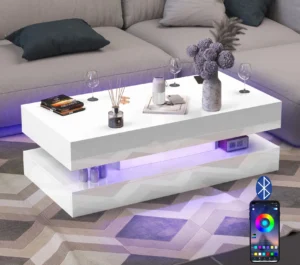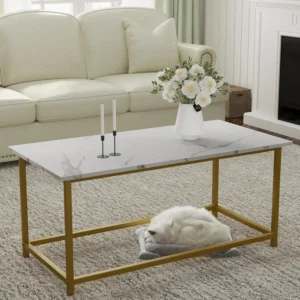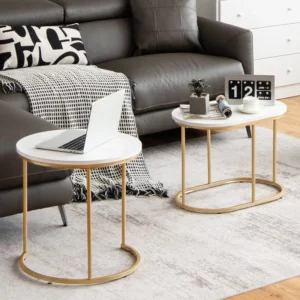Understanding the Impact of Your Coffee Table Shape with a Sectional Sofa
Selecting the perfect coffee table for your sectional sofa involves more than just picking a piece you like. It’s about creating harmony between two significant furniture pieces while ensuring your space remains functional and visually appealing. The shape of your coffee table plays a crucial role in this relationship, affecting everything from how people move through your living room to the overall aesthetic balance of your space.
When pairing a coffee table with a sectional, you’re essentially solving a spatial puzzle. The right table shape complements your sectional’s lines, provides adequate surface area for your needs, and allows comfortable movement throughout the room. The wrong choice can disrupt traffic flow, create awkward spaces, or throw off the visual balance of your carefully designed living area.
Understanding the fundamentals of intelligent black mid-century coffee tables can provide valuable insight into how different shapes interact with various sectional configurations. Whether you have an L-shaped sectional with a distinct corner, a sprawling U-shaped design that wraps around three sides, or a chaise sectional with an extended lounging area, your coffee table selection should respond to these specific arrangements.
This guide explores the distinct advantages of both round and square coffee tables when paired with sectionals, along with critical considerations for proportion, traffic flow, and functionality. We’ll also address practical concerns for coffee table large sectional pairings, which present unique challenges due to their substantial scale. By the end, you’ll have all the knowledge needed to confidently select the perfect coffee table shape for your specific sectional arrangement.
The Case for Round Coffee Tables with Sectionals
Round coffee tables offer a beautiful counterpoint to the angular nature of most sectional sofas. This intentional contrast between shapes creates visual interest and prevents your furniture arrangement from feeling too rigid or boxy. The gentle curves of a round table introduce a softer element that balances the strong geometric lines typically found in sectional designs.
One of the most significant advantages of round tables with sectionals is improved traffic flow. Without sharp corners to navigate around, family members and guests can move more freely through the living space. This benefit becomes particularly noticeable in smaller rooms or arrangements where the walking path between the sectional and coffee table might be limited.
Consider these key benefits of round coffee tables with sectionals:
- Safety enhancement: The absence of sharp corners reduces the risk of painful bumps and bruises, making round tables an excellent choice for households with young children, elderly family members, or active pets.
- Space efficiency perception: Round tables often appear to take up less space visually, helping a room with a large sectional feel less crowded.
- Equal accessibility: Everyone seated around the sectional has relatively equal access to the table surface, promoting better conversation and social interaction.
- Softened visual impact: The curved edges create a more relaxed, inviting atmosphere that balances the structured lines of sectional sofas.
For optimal functionality, ensure at least 14-18 inches of clearance between your round coffee table and the sectional. This space allows comfortable leg room while keeping the table within easy reach. Many homeowners find that round coffee tables cozy seating arrangements create a more intimate atmosphere that encourages conversation.
The versatile mid-century modern round coffee tables available today come in various sizes and materials to complement virtually any sectional style. From glass tops that create an airy feel to substantial wooden designs that anchor the space, round tables offer both aesthetic appeal and practical benefits that make them serious contenders for sectional pairings.
The Case for Square Coffee Tables with Sectionals
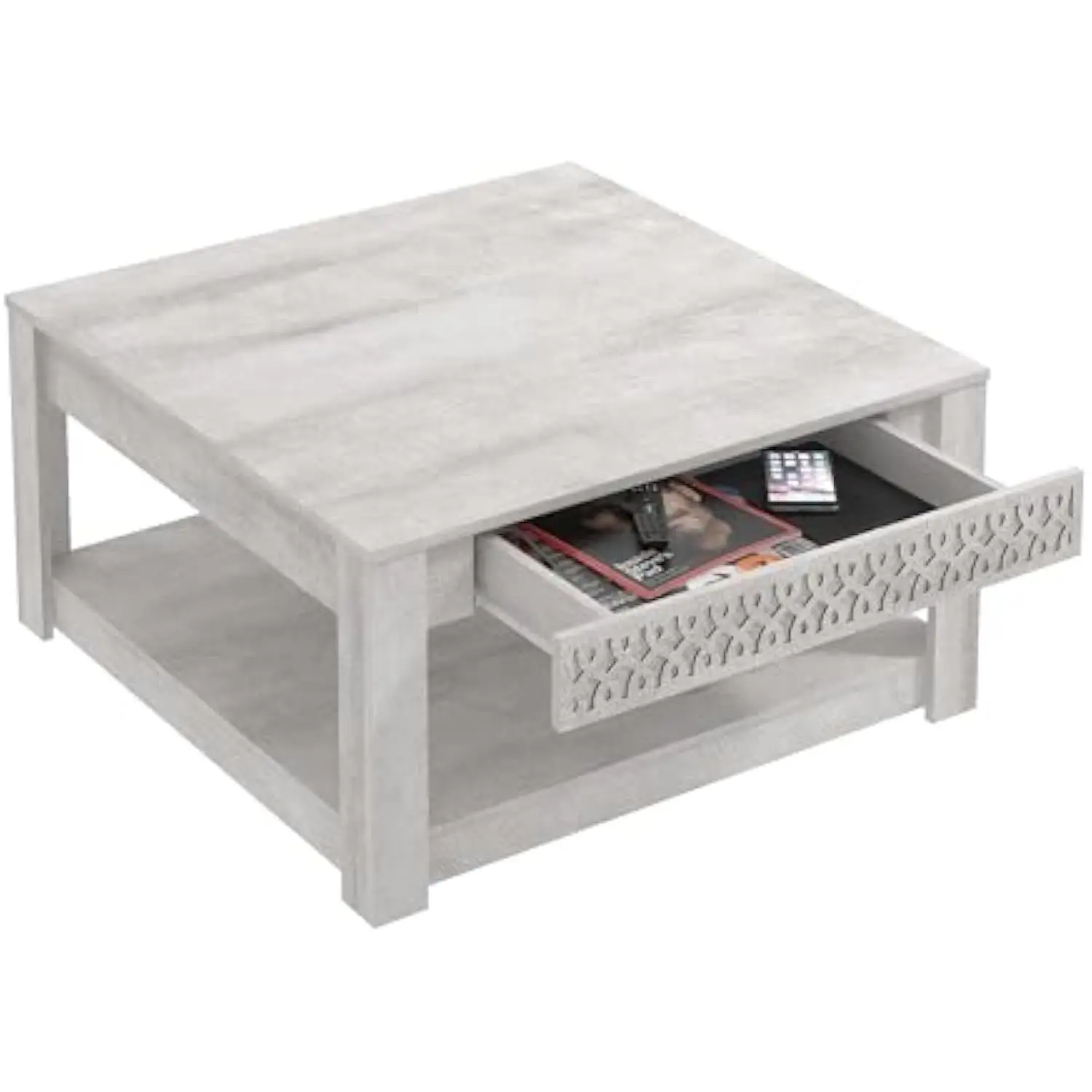
Square coffee tables provide a natural geometric complement to the angular lines of most sectional sofas. This shape harmony creates a cohesive, intentional look that many interior designers favor for contemporary and structured living spaces. The parallel and perpendicular relationships between the furniture pieces establish a sense of order and deliberate arrangement.
One of the most compelling advantages of square coffee tables is their maximized usable surface area. Unlike round tables, which lose corner space to their curved design, square tables offer edge-to-edge functionality with no wasted space. This makes them particularly valuable for families who regularly use their coffee table for multiple activities beyond just holding drinks.
Key benefits of square coffee tables with sectionals include:
- Enhanced surface utility: The straight edges provide more usable space for books, remote controls, decorative objects, and serving items.
- Space definition: Square tables help establish clear zones in open floor plans, creating a defined living area bordered by the sectional.
- Storage potential: Many square coffee table designs incorporate drawers, shelves, or hidden compartments that round tables typically cannot accommodate.
- Visual anchoring: In larger rooms with substantial sectionals, a square coffee table provides a strong visual anchor that grounds the seating arrangement.
- Nesting potential: Square tables often come in sets that can be nested or arranged in various configurations to adapt to changing needs.
The practical advantages of square coffee tables are examined in detail in our definitive guide advantages square coffee tables, which explores their functional benefits beyond mere aesthetics. For sectional owners, these practical considerations often become decisive factors.
Our collection of mid-century modern square coffee tables showcases how this shape can complement sectional arrangements with clean lines and balanced proportions. The right square coffee table doesn’t just serve a functional purpose—it becomes an integral design element that enhances your sectional’s presence in the room.
Direct Comparison: Round vs. Square for Different Aspects
When choosing between round and square coffee tables for your sectional, consider these side-by-side comparisons across key factors:
Visual Aesthetics:
* Round Tables: Create contrast with sectional angles; soften the overall look; introduce flowing lines to balance rigid geometry
* Square Tables: Reinforce geometric harmony; provide clean, intentional lines; create cohesive modern aesthetic
Traffic Flow:
* Round Tables: Allow smoother movement without corner obstacles; reduce collision points; work better in tight spaces
* Square Tables: Create more defined walkways; may require more clearance space; better when placed in central open areas
Surface Functionality:
* Round Tables: Less total surface area; no corners for placement; better for conversation-focused settings
* Square Tables: Maximum usable surface; stable corners for precarious items; better for activities like games or crafts
Safety Considerations:
* Round Tables: No sharp corners; reduced injury risk; safer for households with children
* Square Tables: Corners may pose hazards; often have firmer edges; may require corner protectors in some households
Scale and Proportion:
* Round Tables: Often appear smaller than they are; work well with curved sectional elements; need proper diameter to balance large sectionals
* Square Tables: Provide strong visual weight; clearly define the space; may overwhelm smaller sectionals if not proportioned correctly
Flexibility:
* Round Tables: More forgiving with placement; can be shifted easily; adapt well to irregular spaces
* Square Tables: Create more defined areas; work better in structured arrangements; often provide storage options
For those considering additional shapes, our guide to rectangular vs square coffee tables offers further comparison points to consider when making this important decision for your sectional arrangement.
Critical Measurements and Proportions for Coffee Table Selection
Achieving the right proportional relationship between your sectional and coffee table is crucial for both aesthetics and functionality. Whether you choose round or square, these measurement guidelines will help ensure a harmonious pairing:
Length/Diameter Proportion: Your coffee table should measure approximately two-thirds the length of your sectional’s main segment. For an L-shaped sectional, use the longer side as your reference. This proportion creates visual balance without overwhelming the space.
Height Relationship: The ideal coffee table sits 1-2 inches below the seat height of your sectional. This height allows comfortable access without awkward reaching or obstructed views across the table. Most sectional seats measure 17-19 inches high, making coffee tables between 15-18 inches tall generally ideal.
Clearance Requirements: Maintain 14-18 inches between your coffee table and sectional. This space provides comfortable leg room while keeping the table within easy reach. For high-traffic areas, consider expanding this to 18-20 inches to improve movement flow.
Walking Path Space: Ensure at least 24-30 inches for main walkways around your furniture arrangement. This clearance is particularly important for the path between your coffee table and any furniture opposite the sectional.
Scale Considerations: Larger sectionals require more substantial coffee tables to maintain visual balance. A small coffee table paired with an oversized sectional will appear disproportionate and functionally inadequate.
Finding ideal square coffee table dimensions becomes simpler when applying these guidelines to your specific sectional configuration. Remember to measure your actual space rather than relying solely on furniture specifications, as real-world arrangements often differ from idealized floor plans.
For round tables, diameter becomes the critical measurement, while square tables require attention to both length and width dimensions. Either shape can work beautifully with your sectional when properly proportioned according to these guidelines.
Best Matches: Coffee Table Shapes for Specific Sectional Types
For L-Shaped Sectionals
L-shaped sectionals create a natural right angle that pairs beautifully with square coffee tables. The parallel lines establish a cohesive geometric relationship that feels intentional and balanced. Place your square table centered on the inside corner of the “L” to create equal accessibility from both sides of the sectional.
For a softer approach with L-shaped sectionals, round coffee tables can be positioned slightly offset from the corner. This arrangement softens the angular junction and creates a more organic flow between the two seating areas. The round shape effectively bridges the corner transition while maintaining accessibility.
For U-Shaped Sectionals
U-shaped sectionals create a more enclosed seating arrangement that typically benefits from round coffee tables. The curved edges allow easier movement within the limited center space and prevent the arrangement from feeling too rigid or confined. A round table centered in the “U” creates natural conversation flow and equal access for all seated positions.
If you prefer a square table with a U-shaped sectional, consider selecting one with slightly smaller dimensions than you might normally choose. This allows adequate clearance for movement while maintaining the structured look. Position it centered within the “U” configuration for balanced accessibility.
For Sectionals with a Chaise
Sectionals with a chaise present an asymmetrical challenge that requires thoughtful table placement. For these configurations, consider the actual seating arrangement rather than the overall sectional shape. Position your coffee table (round or square) centered on the main seating segment opposite the chaise.
Round tables often work well with chaise sectionals because they can be positioned flexibly to accommodate the irregular seating pattern. Square tables provide more defined structure but may require more precise placement to ensure they don’t obstruct movement around the chaise extension.
For Symmetrical/Pit Sectionals
Large, symmetrical sectionals or pit-style arrangements require substantial coffee tables that can serve multiple seating positions. Square or rectangular tables often provide the necessary surface area, while round tables with larger diameters can soften the massive appearance of these sectional types.
With pit sectionals, consider the reach distance from all seating positions. The coffee table should be accessible without requiring uncomfortable stretching, which often makes central placement with adequate sizing crucial regardless of shape choice.
Beyond Round and Square: Other Coffee Table Shapes to Consider
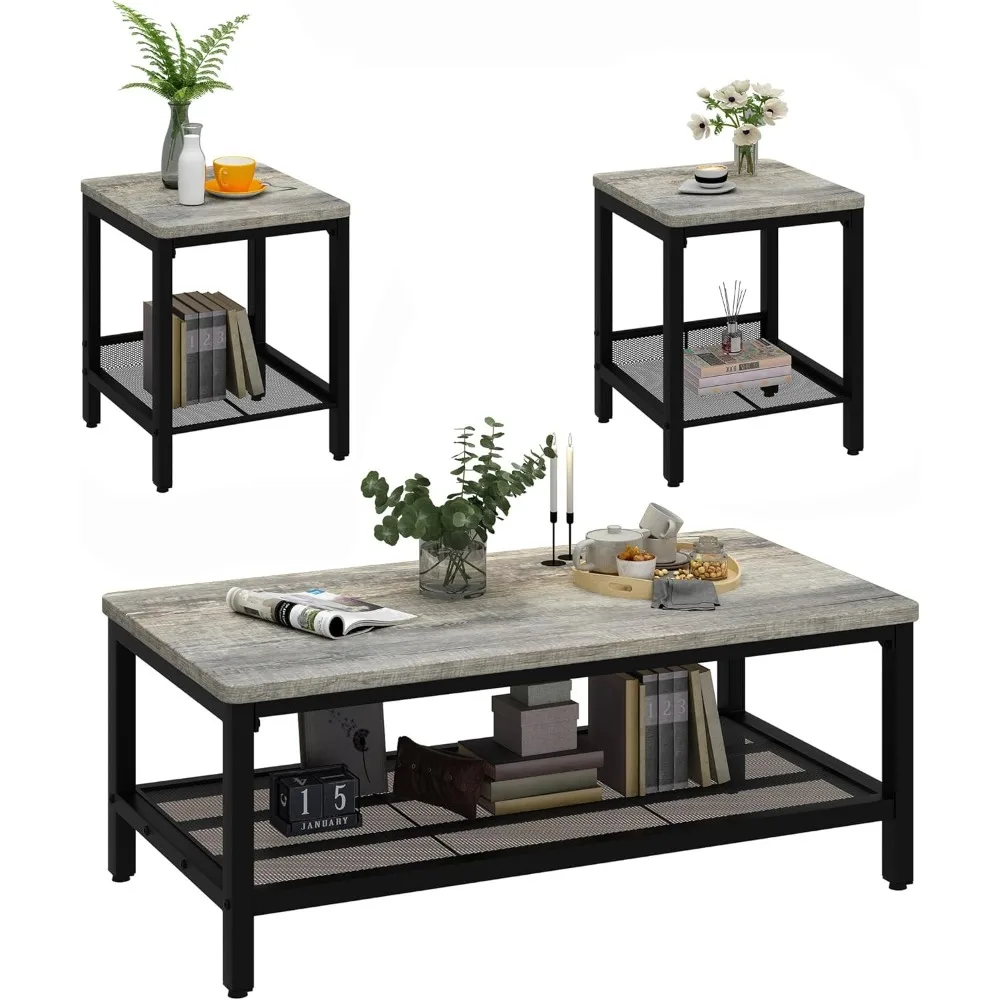
While round and square coffee tables represent the most common options for sectional pairings, several alternative shapes offer compelling benefits worth considering:
Oval Coffee Tables function as an elegant compromise between round and rectangular shapes. They provide the smooth, corner-free benefits of round tables while offering the extended surface area similar to rectangular designs. For sectionals with longer primary segments, oval tables provide proportional balance without the sharp corners of rectangular alternatives.
Rectangular Coffee Tables excel when paired with extra-long sectionals where a square table might appear undersized or a round table wouldn’t provide sufficient surface area. They maintain the clean lines of square tables while extending to match longer seating arrangements. Position these parallel to the main sectional segment for the most balanced appearance.
Nesting Tables offer exceptional versatility with sectional arrangements. These mid-century modern nesting coffee tables can be arranged in various configurations to serve different seating positions or pulled apart when entertaining larger groups. Their adaptability makes them particularly valuable for households where the sectional serves multiple purposes throughout the day.
Organic/Freeform Shapes introduce a unique design element that can complement both modern and eclectic sectional styles. These non-standard shapes often feature curved edges with irregular contours that create visual interest while still providing functional surfaces. They work particularly well in design-forward spaces where the coffee table serves as a conversation piece.
Multi-level Tables address the varied height needs that often arise with sectional arrangements. With surfaces at different elevations, these tables can simultaneously serve the main seating area while providing appropriate-height surfaces for side sections or chaise components. The oval coffee tables enhance room flow with their smooth contours while maintaining substantial surface area.
These alternative shapes demonstrate that the round versus square debate represents just a starting point in your coffee table selection process. The perfect table for your sectional might incorporate elements of both traditional shapes or introduce entirely new geometry that specifically addresses your unique arrangement.
Material and Style Considerations for Sectional Coffee Tables
The material of your coffee table significantly affects how its shape interacts with your sectional. Different materials create varying visual weights that can either balance or overwhelm your seating arrangement:
Glass Tops create an airy, lightweight appearance that helps prevent small spaces from feeling crowded by large sectionals. Mid-century modern glass top coffee tables allow light to pass through, reducing visual bulk while maintaining functional surface area. The transparency works particularly well with substantial sectionals by creating visual space.
Solid Wood provides warmth and substantial presence that can anchor larger sectional arrangements. The natural material adds textural contrast to upholstered seating while establishing a durable centerpiece. Wood edges on round tables feel softer than their square counterparts, while square wooden tables create more definitive boundaries.
Metal Frames offer slim profiles that complement modern sectional designs. Whether supporting glass tops or paired with wood elements, metal introduces a contemporary edge that works well with clean-lined sectionals. The material’s inherent strength allows for more delicate proportions without sacrificing stability.
Stone and Concrete bring substantial weight and organic texture to sectional arrangements. These materials create grounding focal points that can balance the visual weight of larger sectionals. Their natural cooling properties also provide practical benefits for hot beverages and warm rooms.
When considering materials, also evaluate how edges are finished. Rounded edges on square tables can provide a safety compromise, while beveled glass edges soften potential hazards without sacrificing the desired shape. For households with children, these details matter significantly when deciding between round and square designs.
Style compatibility between your coffee table and sectional creates cohesion in your living space. Mid-century modern coffee tables pair beautifully with both contemporary and traditional sectionals through their balanced proportions and timeless lines. The clean geometry of both round and square tables in this style works particularly well when the material and finish complement your sectional’s character.
Your Decision Framework: How to Choose the Right Shape
To determine whether a round or square coffee table will better suit your sectional, work through these assessment questions:
What is your sectional configuration?
– L-shaped configurations often work well with square tables that echo the corner angle
– U-shaped arrangements typically benefit from round tables that enhance movement in the enclosed space
– Chaise sectionals may need asymmetrical placement regardless of table shapeHow much traffic flows through your space?
– High-traffic areas benefit from round tables without corners to navigate
– More stationary arrangements can accommodate square tables with less concern for movement pathsWho regularly uses the space?
– Households with children or elderly members may prioritize the safety of round tables
– Adult-only households might focus more on functionality and aesthetic preferencesWhat activities typically occur at your coffee table?
– Game playing and extensive surface use favor square tables with maximum usable area
– Conversation-focused settings benefit from the social geometry of round tablesWhat is your existing design aesthetic?
– Contemporary, geometric interiors often complement square tables
– Softer, more organic design schemes may better suit round tablesHow much surface area do you regularly need?
– Larger families or entertainers might prefer the maximized space of square tables
– Smaller households with minimal surface needs might prioritize the flow benefits of round options
After considering these questions, try this practical exercise: Use painter’s tape to mark out the footprint of both a round and square table in your space. Live with these outlines for a few days, observing how you navigate around them and visualizing how each shape would function with your sectional.
The thoughtful consideration of black mid-century coffee table design principles can further inform your decision by highlighting how different shapes interact with your specific sectional style and room configuration.
Harmony in Design: Creating Balance with Your Selection
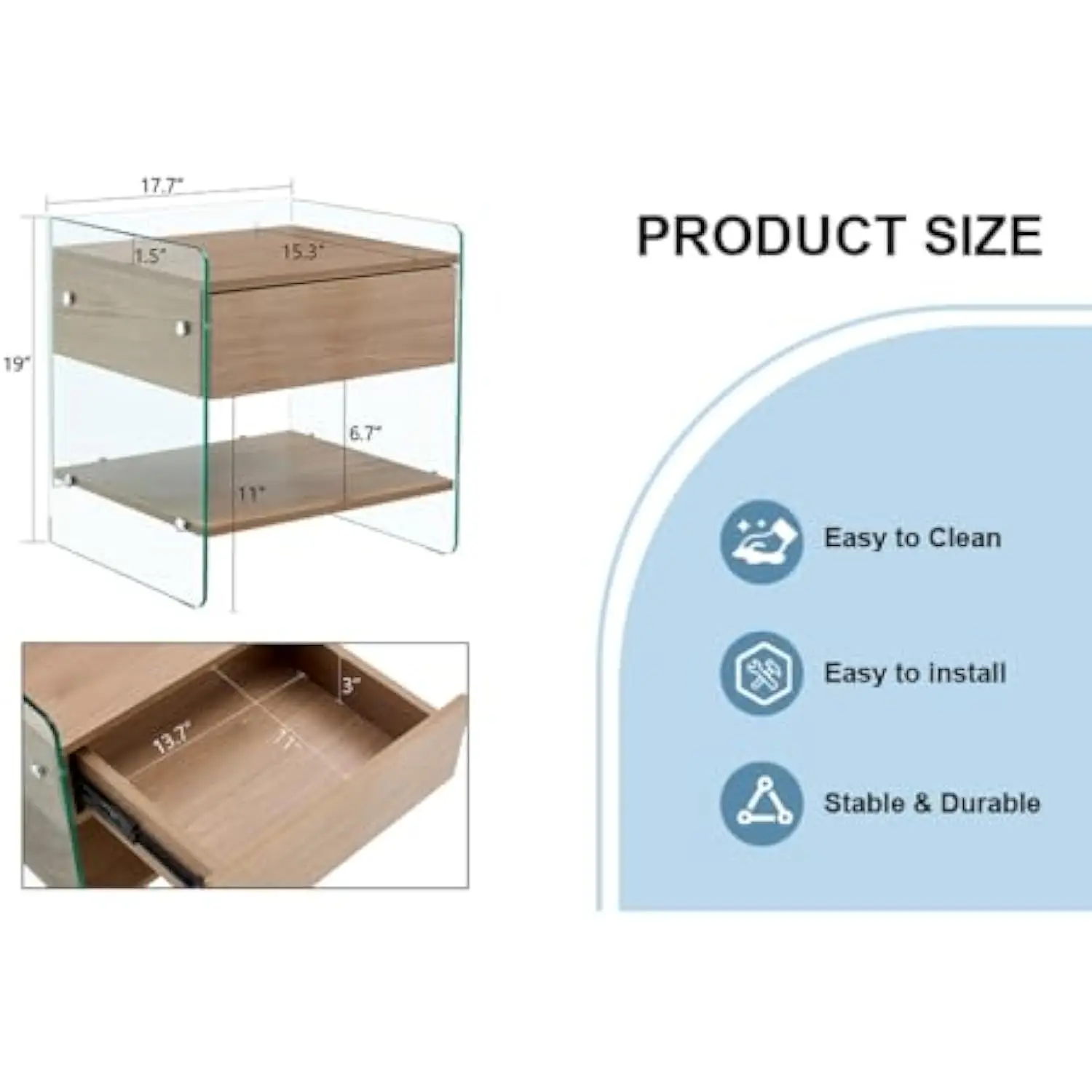
Creating visual harmony between your sectional and coffee table involves understanding fundamental design principles that transcend specific shapes. The relationship between these two significant pieces establishes the foundation of your living space’s composition.
Balance in furniture arrangement doesn’t necessarily mean symmetry. A large sectional creates substantial visual weight that needs appropriate counterbalancing. Round coffee tables achieve this through their continuous form and lack of corners, while square tables establish balance through parallel relationships and defined boundaries. Either approach can create harmony when executed thoughtfully.
Intentional contrast often creates the most interesting interiors. The juxtaposition of a curved round table against the angular lines of a sectional introduces visual tension that draws the eye and creates dynamic energy. Conversely, reinforcing the geometric nature of a sectional with a square table creates cohesive strength through repetition of form. Both strategies have merit depending on your desired atmosphere.
Scale relationship remains critical regardless of which shape you select. An oversized sectional paired with an undersized coffee table creates uncomfortable imbalance that affects both appearance and functionality. The substantial presence of sectional seating demands a coffee table with appropriate visual weight achieved through size, material, and design.
The principles for styling black mid-century coffee table arrangements apply equally to both round and square options. Focus on creating conversation areas where people can comfortably interact, establishing appropriate height relationships between surfaces, and ensuring the coffee table complements rather than competes with your sectional’s presence.
Maximizing Functionality: Sectional Coffee Table Arrangements for Different Activities
Your coffee table serves as more than just a decorative element—it’s a functional surface supporting various activities. Consider how different shapes perform for your household’s specific needs:
For Entertainment and Hosting
Round tables facilitate conversation by eliminating barriers between guests. Everyone seated around the sectional has relatively equal access to shared items like appetizer plates or drink coasters. Square tables provide more stable surfaces for serving platters and accommodate more items without crowding.
For Family Game Nights
Square coffee tables create ideal surfaces for board games with their stable corners and maximized area. Round tables work better for card games where players need equal access from different positions around the sectional. Consider a table with sufficient size to accommodate your favorite games while maintaining comfortable reach distances.
For Regular TV Watching
Either shape works well for casual TV viewing, though round tables make navigation easier when getting up for snack refills or bathroom breaks. Square tables provide more defined spaces for organizing remotes, magazines, and snacks for multiple viewers.
For Work-From-Home Settings
Square tables provide stable surfaces for laptops and papers when your sectional doubles as a workspace. Round tables create less defined work boundaries but allow easier movement between the coffee table workspace and the comfort of the sectional for reading or phone calls.
Mid-century modern lift top coffee tables offer versatile functionality that adapts to these various activities regardless of shape. Their adjustable surfaces provide ergonomic height for work tasks while maintaining appropriate proportions for decorative and entertainment functions.
Mid-Century Modern Glass Top Coffee Tables, Mid-Century Modern Glass Top Side & End Tables
$460.58 Select options This product has multiple variants. The options may be chosen on the product pageMid-Century Modern Glass Top Coffee Tables, Mid-Century Modern Vintage Coffee Tables, Mid-Century Modern Vintage Side & End Tables
$725.36 Select options This product has multiple variants. The options may be chosen on the product pageMid-Century Modern Lift Top Coffee Tables, Mid-Century Modern Square Coffee Tables
$454.73 Select options This product has multiple variants. The options may be chosen on the product pageMid-Century Modern Large Coffee Tables, Mid-Century Modern Rectangular Coffee Tables
$603.26 Select options This product has multiple variants. The options may be chosen on the product pageMid-Century Modern Marble Top Coffee Tables, Mid-Century Modern Rectangular Coffee Tables, Mid-Century Modern White Coffee Tables
Price range: $163.28 through $189.22 Select options This product has multiple variants. The options may be chosen on the product pageMid-Century Modern Nesting Coffee Tables, Mid-Century Modern Nesting Table Sets
$361.45 Select options This product has multiple variants. The options may be chosen on the product page
Frequently Asked Questions about Coffee Tables for Sectionals
Can I use multiple small tables instead of one large coffee table with my sectional?
Yes, a cluster of smaller tables offers flexible functionality with sectionals. This arrangement allows you to move tables to serve different sections of your seating area and create varied height levels for visual interest. For best results, choose tables that share design elements but vary slightly in size and height to create a cohesive grouping.
Is it better to match the coffee table to the sectional or other room furniture?
Rather than direct matching, focus on complementary relationships. Your coffee table should relate to your sectional through contrasting elements (material, shape, or color) while connecting to other room furniture through shared design characteristics. This approach creates cohesive design without appearing overly coordinated.
Should the coffee table be lighter or darker than my sectional?
This depends on your desired visual effect. Lighter tables create airy contrast against dark sectionals and can make the space feel larger. Darker tables anchor the arrangement and create sophisticated contrast against lighter upholstery. The most important factor is creating intentional contrast rather than an identical color match.
Can I use an ottoman instead of a traditional coffee table with my sectional?
Ottomans make excellent alternatives to traditional coffee tables, especially with sectionals. They provide soft edges for safety, additional seating when needed, and often incorporate storage. Add a large tray to create a stable surface for drinks and decorative items while maintaining the flexibility to remove it when using the ottoman for seating.
How do I know if my coffee table is too big or too small for my sectional?
A properly sized coffee table allows 14-18 inches of clearance between the table and sectional while still providing comfortable reach distance from all seating positions. If movement feels restricted or the table appears dwarfed by the sectional, your proportions need adjustment. Our guide to round vs rectangle coffee tables provides additional sizing guidance for different shapes.
Expert Tips: Interior Designer Insights on Coffee Table Selection
• Consider your sectional’s arm height when selecting a coffee table. Tables slightly lower than the arms create a pleasing layered effect while maintaining functional accessibility.
• For sectionals with built-in recliners or motion features, prioritize coffee tables that can be easily moved or tables with C-shaped bases that allow the table to pull closer when needed.
• Use your coffee table to introduce a contrasting material to your seating area. If your sectional features soft textiles, consider a coffee table with harder elements like stone, glass, or metal to create textural balance.
• For open concept spaces, select a coffee table shape that helps define the boundaries of your living area. Square and rectangular tables establish clearer spatial definitions than round or oval options.
• Consider the view of your coffee table from all angles, including from entry points to the room. Round tables look similar from all approaches, while square tables present different aspects depending on the viewing angle.
• For the most versatile arrangement, select a coffee table approximately two-thirds the length of your main sectional piece with a height about one inch lower than your sectional’s seat height.
• Explore table options with adjustable features that adapt to different activities. The best shape coffee table small space options often incorporate height-adjustable or expandable surfaces that maximize functionality without overwhelming limited square footage.
What About Oval and Rectangular Coffee Tables with Sectionals?
Oval coffee tables offer a sophisticated compromise between round and rectangular shapes, combining the smooth flow of curved edges with the elongated proportions that complement many sectional arrangements. Without sharp corners to navigate, oval tables enhance movement while providing extended surface area that better parallels longer sectional segments.
The gentle curve of oval tables softens the overall appearance of angular sectional arrangements while maintaining sufficient surface area for practical use. This shape works particularly well with curved sectional components or arrangements featuring both straight and curved elements, creating a visual bridge between different seating profiles.
Rectangular coffee tables excel with longer sectional configurations where proportional balance becomes critical. The extended linear shape creates a natural parallel relationship with the sectional’s main segment. Mid-century modern rectangular coffee tables offer clean lines and balanced proportions that complement the substantial presence of sectional seating.
When placing rectangular tables, position them parallel to the sectional’s longest segment rather than perpendicular to it. This orientation enhances the natural flow of the furniture grouping while maintaining accessibility from multiple seating positions. For L-shaped sectionals, centering the rectangular table on the corner junction creates balanced access from both wings.
Unlike the either/or debate between round and square options, oval and rectangular tables represent refined variations that address specific sectional configurations. Their elongated proportions often create more appropriate scale relationships with larger sectional arrangements while maintaining the distinctive benefits of their basic geometric family.
Is One Shape Safer Than the Other for Households with Children?
In households with young children, safety considerations often influence furniture selection significantly. Round coffee tables offer clear safety advantages with their absence of sharp corners. The continuous curved edge eliminates the precise points of impact that can cause injury when children run or fall near the table.
However, safety encompasses more than just shape. Material choices and edge treatments significantly affect how safe any coffee table will be, regardless of its basic geometry. Consider these safety-focused options:
- Glass tops should always be tempered safety glass that breaks into small, dull pieces rather than sharp shards if damaged
- Wood tables benefit from rounded or beveled edge treatments even on square designs
- Soft materials like upholstered ottomans or padded edge protectors minimize injury risk
- Stable, wide bases prevent tipping hazards regardless of shape
- Lower-height tables reduce the potential impact force if a child falls onto the table edge
For families seeking maximum safety without sacrificing style, consider coffee tables with rounded corners that maintain a generally rectangular shape. These hybrid designs provide the functional benefits of straight edges where they meet the sectional while eliminating the hazardous corners facing the room’s interior where children typically play.
Corner protectors and edge guards offer additional safety for existing square or rectangular tables, though these temporary solutions may detract from the table’s aesthetic appeal. For many families with young children, round coffee tables or soft ottomans provide the simplest safety solution during the early years.
The Final Verdict: There Is No “One Size Fits All” Answer
After exploring the nuances of both round and square coffee tables with sectionals, we arrive at a conclusion that honors the complexity of this design decision: there is no universally “correct” shape that works for every sectional arrangement. The right choice depends entirely on your specific circumstances, preferences, and priorities.
Round coffee tables excel in creating smooth traffic flow, enhancing safety, and softening the angular nature of most sectionals. Their continuous form facilitates conversation and creates visual contrast that many find appealing. Square coffee tables offer maximized surface area, strong visual definition, and often incorporate valuable storage features that enhance functionality.
Your decision should prioritize the factors most important to your household. If you frequently entertain, have young children, or deal with limited space, a round table might serve you best. If you value surface stability, need maximum usable area, or prefer geometric harmony, a square table could be your ideal match.
Remember to measure your specific space carefully before purchasing. The perfect coffee table complements your sectional’s proportions while allowing comfortable clearance for movement and use. By thoughtfully considering the unique characteristics of your sectional, room dimensions, and household needs, you’ll select a coffee table shape that enhances both the function and beauty of your living space.





